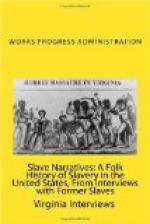“I couldn’t get nobody to go with me, so I started out afoot across the prairies for Kansas. After I got some distance from home it was all prairie. I had to walk all day long following buffalo trail. At night I would go off a little ways from the trail and lay down and sleep. In the morning I’d wake up and could see nothing but the sun and prairie. Not a house, not a tree, no living thing, not even could I hear a bird. I had little to eat, I had a little bread in my pocket. I didn’t even have a pocket knife, no weapon of any kind. I was not afraid, but I wouldn’t start out that way again. The only shade I could find in the daytime was the rosin weed on the prairie. I would lay down so it would throw the shade in my face and rest, then get up and go again. It was in the spring of the year in June. I came to Lawrence, Kansas, where I stayed two years working on the farm. In 1874 I went to work for a man by the month at $35 a month and I made more money than the owner did, because the grasshoppers ate up the crops. I was hired to cut up the corn for him, but the grasshoppers ate it up first. He could not pay me for sometime. Grasshoppers were so thick you couldn’t step on the ground without stepping on about a dozen at each step. I got my money and came to Ottawa in December 1874, about Christmas time.”
“My master’s name was Simms and I was known as Simms Bill, just like horses. When I came out here I just changed my name from Simms Bill, to Bill Simms.”
“Ottawa was very small at the time I came here, and there were several Indians close by that used to come to town. The Indians held their war dance on what is now the courthouse grounds. I planted the trees that are now standing on the courthouse grounds. I still planted trees until three or four years ago. There were few farms fenced and what were, were on the streams. The prairie land was all open. This is what North Ottawa was, nothing but prairie north of Logan Street, and a few houses between Logan Street and the river. Ottawa didn’t have many business houses. There was also an oil mill where they bought castor beans, and made castor oil on the north side of the Marais des Cygnes River one block west of Main Street. There was one hotel, which was called Leafton House and it stood on what is now the southwest corner of Main and Second Streets.”
“I knew Peter Kaiser, when I came here, and A.P. Elder was just a boy then.”
“The people lived pretty primitive. We didn’t have kerosene. Our only lights were tallow candles, mostly grease lamps, they were just a pan with grease in it, and one end of the rag dragging out over the side which we would light. There were no sewers at that time.”
“I had no chance to go to school when a boy, but after I came to Kansas I was too old to go to school, and I had to work, but I attended night school, and learned to read and write and figure.”
“The farm land was nearly all broke up by ox teams, using about six oxen on a plow. In Missouri we lived near the Santa Fe trail, and the settlers traveling on the trail used oxen, and some of them used cows. The cows seem to stand the road better than the oxen and also gave some milk. The travelers usually aimed to reach the prairie States in the spring, so they could have grass for their oxen and horses during the summer.”




